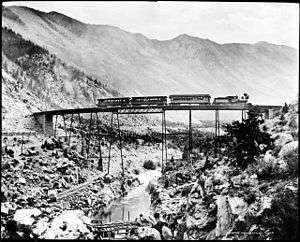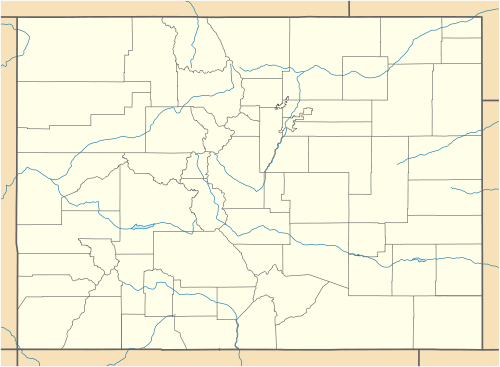Georgetown Loop Railroad
| Georgetown Loop Railroad | |
|---|---|
 Train on the Georgetown Loop Railroad, about 1885. | |
| Locale | Georgetown, Colorado |
| Terminus | Silver Plume, Colorado |
| Commercial operations | |
| Original gauge | 3 ft (914 mm) |
| Preserved operations | |
| Owned by | Colorado Historical Society |
| Operated by | Historic Rail Adventures, LLC[1] |
| Reporting mark | GLRX |
| Length | 4.5 mi (7.2 km) |
| Preserved gauge | 3 ft (914 mm) |
| Commercial history | |
| Opened | 1884 |
| Closed | 1939 |
| Preservation history | |
| 1984 | Reopened |
|
Georgetown Loop Railroad | |
  | |
| Nearest city | Silver Plume, Colorado |
| Built | 1877 |
| NRHP Reference # | 70000909[2] |
| CSRHP # | 5CC.9 |
| Added to NRHP | December 18, 1970 |
| {{{events1}}} | |

The Georgetown Loop Railroad is a 3 ft (914 mm) narrow gauge heritage railroad located in the Rocky Mountains in Clear Creek County, Colorado, in the United States.
The railroad operates summer tourist trains between the communities of Georgetown and Silver Plume, a distance of 2 miles (3.2 km). The railroad route is 4.5 miles (7.2 km) long and ascends an elevation of 640 feet (195.1 m) through mountainous terrain along with trestles, cuts, fills, and a grand loop.[3][4]
History
The Georgetown Loop Railroad was one of Colorado’s first visitor attractions. This spectacular stretch of 3 ft (914 mm) narrow gauge railroad was completed in 1884 and considered an engineering marvel for its time. The thriving mining towns of Georgetown and Silver Plume lie 2 miles (3.2 km) apart in the steep, narrow canyon of Clear Creek in the Rocky Mountains west of Denver. Engineers designed a corkscrew route that traveled nearly twice that distance to connect them, slowly gaining more than 600 feet (183 m) in elevation. The route included horseshoe curves, grades of up to 4%, and four bridges across Clear Creek, including the massive Devil’s Gate High Bridge.
The Georgetown, Breckenridge, and Leadville Railroad had been formed in 1881 under the Union Pacific Railroad.[5] The Loop portion of the line was the crowning segment of the line, crossing the top of the gorge on a 95-foot (29 m) high trestle.
Originally part of the larger line of the Colorado Central Railroad constructed in the 1870s and 1880s, in the wake of the Colorado Gold Rush, this line was also used extensively during the silver boom of the 1880s to haul silver ore from the mines at Silver Plume. In 1893, the Colorado and Southern Railway took over the line and operated it for passengers and freight until 1938.
Between 1906 and 1918, the Georgetown Loop connected with the Argentine Central Railway in Silver Plume, by which tourists could continue onward to the summit of Mount McClellan. Prior to 1916, the Argentine Central also served several large silver mines on the east side of Argentine Pass.
The line was later dismantled, but was restored in the 1980s to operate during summer months as a tourist railroad, carrying passengers using historic 3 ft (914 mm) narrow gauge steam locomotives.
Reopening
In 1959, the centennial year of the discovery of gold in Georgetown, the Georgetown Loop Historic Mining & Railroad Park was formed by the Colorado Historical Society.[6] The Colorado Historical Society’s chairman negotiated a donation of mining claims and mills, and nearly 100 acres (40 ha) of land.
Interest in restoration of the Loop segment as a tourist attraction in the 1970s led to reopening of the segment. Rail line construction began in 1973 with track and ties donated by the Union Pacific Railroad, and a new high bridge was built. The 3-mile (4.8 km) restored segment, opened on March 10, 1984, is at the upper end of the historic Colorado Central main line up Clear Creek Canyon west of Golden. The Georgetown Loop Railroad climbs approximately 640 feet (195 m) between the two towns using 3 miles of track. Passengers can board the train at depots located in Silver Plume and Devils Gate 3/4 of a mile west of Georgetown.
The train ride includes an optional walking tour of the Lebanon Silver Mine, located at the halfway point on the railroad, where visitors can walk 500 feet (150 m) into a mine tunnel bored in the 1870s, with guides pointing out once-rich veins of silver and relating the history of the mine.
See also
- National Register of Historic Places listings in Clear Creek County, Colorado
- List of Colorado historic railroads
- List of heritage railroads in the United States
References
- ↑ Neligh, Ian (May 2009). "Railstar replaced as Loop operator: Local businessman takes over railroad". Clear Creek Courant. Retrieved 2015-07-11.
- ↑ National Park Service (2010-07-09). "National Register Information System". National Register of Historic Places. National Park Service.
- ↑ "Georgetown Look Historic Mining and Railroad Park". History Colorado. History Colorado, the Colorado Historical Society. Retrieved 3 October 2011.
- ↑ Trains May, 2007 p 56
- ↑ Colorado Historical Society: Colorado Timeline
- ↑ Colorado Historical Society
External links
| Wikimedia Commons has media related to Rail transport in Colorado. |
- Georgetown Loop Historic Mining & Railroad Park, Historical information site
- Georgetown Loop Railroad, Tourism site
Coordinates: 39°41′42″N 105°43′27″W / 39.694999°N 105.724124°W

